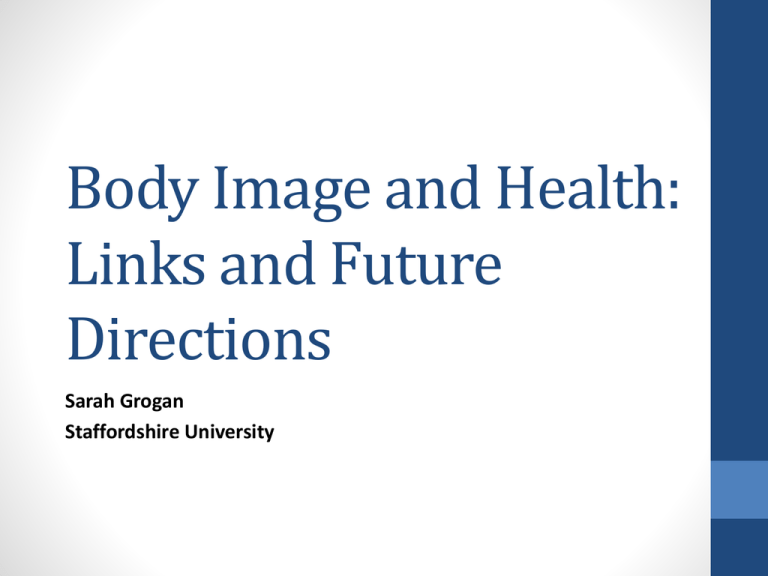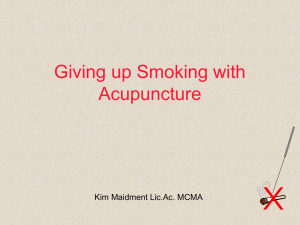Using Appearance Concerns to Improve People*s Health
advertisement

Body Image and Health: Links and Future Directions Sarah Grogan Staffordshire University Using Appearance Focused Messages in Health Promotion • Lifestyle-related illnesses present a significant economic burden to the National Health Service (heart disease alone costs an estimated £30 billion to the UK economy per year; British Heart Foundation, 2012). • Health-related campaigns fail to motivate many people to change their behaviour. Many feel that health-related threats are too long- term to concern them and/or not relevant to them (Grogan & Masterson, 2012). • If some health-risking behaviours are linked to body image then it may be possible to improve health through using appearance-focused messages in health promotion. Body Image ‘A person’s perceptions, thoughts and feelings about his or her body’ Grogan, 2008: 1. A significant number of women and men in westernised countries are dissatisfied with some aspect of their bodies (Tiggemann, 2011). Ideals are fairly similar for women and men of all ages and centre around a slender muscular ideal for men and a ‘slender but shapely’ ideal for women (Grogan, 2008). • • • • Exercise Anabolic Steroid Use Healthy eating Smoking 1. What Are The Links With Body Image? 2. Future Directions to Promote Better Health? Exercise Exercise Moderate to high intensity exercise reduces blood pressure, helps to control weight, and reduces resting heart rate (American Heart Association, 2012). However,Department for Culture Media and Sport (2011) survey found that only about half of UK adults (53.1%) had engaged in ANY 30 minute period of exercise in the 4 weeks prior to interview. Exercise and Body Image Where people have been allocated randomly to exercise programmes or control groups, more positive body image tends to result in the exercise groups (Martin Ginis & Bassett, 2012; Byron-Daniel, 2012). • This effect has been seen in men, women and children and does not seem to depend on the type of exercise. • Greater improvements with more frequent and moderate to high intensity exercise. • Greatest improvements in those with initially poorer body image. • Self efficacy: Exercise can make people feel more control over their bodies and can also help them to focus on internal factors (feelings of fitness and body function) rather than external factors (such as how they look to others). Exercise Intervention With Adolescent Girls With Poor Body Image Burgess, Burwitz & Grogan (2006) • Fifty 13-14 year old girls pre-selected for low self esteem and high body dissatisfaction • Participation in 6 weeks aerobic dance program significantly reduced body dissatisfaction & enhanced physical selfperceptions. • Focus groups following sessions: Girls felt more positive about their bodies and about exercise programmes. Clothing, noncompetitive environment, and focus on enjoyment all positive aspects of the programme. Designing exercise interventions to promote body acceptance Grogan, Williams, Kilgariff, Bunce, Padilla, Woodhouse, Heyland, & Davies, Submitted. • Dance intervention focusing on natural movement, body acceptance, body connectivity, feeling rather than viewing the body. • Facilitator wore loose clothing, no make-up. • Mirrors were covered (Prichard & Tiggemann, 2010). • Thirteen 17-year olds (7 girls and 6 boys) took part in the dance intervention followed by focus groups and interviews. • Young men and young women reported feeling more connected to their bodies, freer and less self-conscious, and more accepting of their bodies after the intervention. • The intervention itself was experienced as fun and relaxing and seemed to be equally acceptable to both boys and girls. All were keen to have more sessions and longer sessions. • “Erm (.) kinda feel like you know your body more. It’s the same body but you kinda see it in a different way” (Emma, Focus Group). • “Actually I think it was good (.) like I said before I think it could be longer [Interviewer: Alright] But (.) that would just improve the positive experience” (James, Individual Session). Factors Predicting Exercise Drop-out Pridgeon & Grogan, 2012 • In-depth, one hour interviews were carried out with fourteen people, aged nineteen to thirty-two years; seven men and two women who had maintained their gym membership and three women and two men who had not. • Making upward comparisons in terms of body image had a positive effect for some male and female exercisers and strengthened their commitment to exercise. • But upward comparisons to female bodies were deflating to women with poor body satisfaction and were an important factor in their drop-out: • Annie: They're all so much skinnier than me and then when all the skinny girls walk in it's like “Oh my God I don't wanna be here” so I walk out. Promoting Exercise • Many gyms and other exercise facilities focus on improving appearance as a way to encourage people to exercise. • For some women and men this may be an effective way to encourage initiation of exercise (Grogan, Conner & Smithson, 2006; Pridgeon & Grogan, 2012). • BUT focusing on appearance may lead to quitting exercise programs (Pridgeon & Grogan, 2012) and pressure to lose weight can lead to drop out (Gillison et al, 2011). • Focusing on internal motivators (health, fitness, and enjoyment) rather than appearance and weight may be most likely to enable people to maintain exercise regimes. Anabolic Steroid Use Health Impacts of Anabolic Steroids • Anabolic steroids widely available in gyms in UK (Grogan et al, 2006) and USA (Hildebrandt & Alfano, 2012). • Synthetic hormones designed to increase muscle mass. • Physical side effects include liver and kidney damage, hair loss, acne, gastric problems, hypertension, increased risk of HIV/AIDS when needles are shared. Body Image in Steroid Users Kanayama, Pope Cohane, & Hudson (2003) 101 US bodybuilders, aged 18-65 Divided into those reporting and not reporting steroid use Asked about training history and use of performance-enhancing drugs, including steroid use. Also How confident did you feel about your body appearance? How much were you preoccupied with your appearance?. Users reported significantly less confidence in their body appearance prior to taking steroids. Conclude that steroid use might be most likely to occur in bodybuilders with lower levels of body satisfaction. Motivations for Steroid Use (Questionnaire Study) Wright, Grogan & Hunter, 2000 Questionnaire with open and closed-ended questions: • Demographic Information • Motivations for Training • Impact of Training on Lifestyles • Attitudes Towards Steroids And for steroid users only…. • Reasons for Taking Steroids • Experiences of Steroid Use • Social Outcomes of Steroid Use Steroids Necessary for Competition? (1 = Strongly Agree -5 = Strongly Disagree)? 4.5 4 3.5 3 2.5 2 1.5 1 0.5 0 Competitors Non Competitors Steroid Non Users Users Q: How did taking steroids change how you felt about your body? • 52.6% • 21.1% • 75.9%: felt good/better increased confidence steroids helped to attain ideal body. • ‘I have gone from being ashamed of my body to being confident, stronger in body and mind. The confidence I have can be directed to my work - application for new jobs, doing things on my own, not afraid when you walk into a job interview - the people taking the interview give you more respect - just because of the way you look.’ Motivations for Steroid Use (Interview Study) Grogan, Evans, Wright, & Hunter, 2006 Interviews with 11 body builders who used steroids (5 women, 6 men). Body Dissatisfaction was key motivator for use: “Really I needed, I felt I needed to be bigger, and basically I thought steroids would do it”. All experienced significant increases in lean muscle mass which they associated with steroid use. These gains were more important than health problems which were experienced as mere irritations. “The kinds of effects of side effects that I’ve noticed are lower back pain, you know, kidney pain, itchiness round the nipple, high blood pressure, water retention, headaches, nothing really major. They’re not, you know, life threatening”. Promoting Reduced Steroid Use • Social context encourages steroid use, and users put faith in information received from others at the gym and from websites and ‘steroid bibles’ “I started using them because I wanted to compete, and if you want to compete as a body builder you’ve got to take steroids and that’s it. It’s as simple as that. Everybody on the stage takes them”. • Need for well-informed health professionals with credibility within this community who can challenge recommended dosages/encourage safer injecting practices. • Also, prevention programmes with body builders are needed to promote body acceptance and challenge hyper-muscular ideals presented in body-building magazines and in competition. Steroid Use Prevention Programmes With Young People Ricciardelli & McCabe (2011) Boys desire “lean muscularity” • Programmes including media literacy components such as Media Smart and Everybody’s Different can help children (particularly boys) to challenge muscular ideal (O’Dea & Yager, 2011). • Community-based programmes have also shown promise in creating awareness of side effects of steroids, creating positive body attitudes, and reducing subsequent use (e.g. Nilsson et al., 2004). Healthy Eating Healthy Eating • Unhealthy eating has been linked to high blood pressure and cardiovascular disease (Blood Pressure Association, 2012). • High fat and sugar and low fruit and vegetable intake have been linked to heart disease, diabetes, stroke, and obesity (Department of Health, 2008). • Purchases of fruit in the UK fell by 0.9% in 2010 and are now 11.6% lower than 2007. Purchases of vegetables were 2.9% lower in 2010 than in 2007 (NHS, 2012). Unhealthy Eating and Body Dissatisfaction • Men and women who score higher on body dissatisfaction tend to report higher levels of dieting and taking pills to reduce weight, and are more likely to eat meat, and less likely to eat fruit than those satisfied with their bodies (e.g. Forrest and Stuhldreher, 2007). • Men and women who are inaccurate in judging their weight are significantly more likely to be engaged in inappropriate weight loss practices such as taking diet pills and laxatives than those with more accurate weight perception (e.g. Wharton et al., 2008). Interview studies Grogan, 2008 • Interviews with 50 UK and US women aged 16-63 years. • Were against ‘fad dieting’. • Seen to be ineffective in the long term and bad for health • ‘When I go on one of those silly diets I actually feel tired. I’m obviously not getting enough energy” • But were reported by most of the women in the study. Morgan and Arcelus , 2009 • Dieting in 15 gay and heterosexual men. • All participants reported some body dissatisfaction and all had considered dieting. • Only four of the fifteen men had actually dieted, with one man losing extreme amounts of weight on a diet of mostly coffee and cigarettes. Promoting healthy eating • Self-esteem approaches such as Everybody’s Different can improve body image and reduce unhealthy eating and dietary restraint (O’Dea, 2012). • Media literacy programmes can also be useful in improving body image, though research on impacts of these on healthy eating is inconclusive (Bergsma & Carney, 2008) • Body Acceptance and Awareness: Healthy, intuitive eating (where people respond to internal hunger and satiety cues rather than ignoring these) is linked with body satisfaction (Tykla, 2012). Enhancing body awareness and acceptance may lead to healthier eating. Smoking Smoking Risks and Incidence • Smoking kills around 114,000 people in the UK each year. This is five times more people than road accidents, overdoses, murder, suicide and HIV all put together. • Although rates of smoking have reduced since the 1970s a significant proportion of the UK population continue to smoke. • Girls have consistently higher rates of smoking than boys. In 2010, 14% of 15-year old girls were regular smokers compared to 10% of boys (All statistics from Cancer Research UK, 2012). Percentage of UK Adult Population Smoking 1970-2010 (Cancer Research UK, 2012) Weight Concern and Smoking • Fear of weight gain may be a disincentive for smoking cessation, particularly for women (Potter et al., 2004). • Young women may also believe that smoking initiation will help to reduce their weight by acting as an appetite suppressant (Stice & Shaw, 2003). • Prospective study in USA found that more negative body image at baseline predicted more difficulty quitting smoking, and women who over-estimated their body size were the least likely to quit smoking by the end of 12-week program (King et al., 2005). Qualitative Work Linking Smoking to Weight Concern Grogan, Gough, Fry & Conner (2009) 24 focus groups with 17-24 year old smokers and non-smokers. • Cigarettes used for appetite control: CHARLOTTE (non-smoker): Yeah, if they’re hungry, they’ll have a cigarette instead of eating because it, like, sedates – is it sedates? – I don’t know, your appetite, it makes you feel that you’re not as hungry and stuff. • Women smokers were concerned about giving up smoking as they believed they would gain weight: ROSIE (smoker): That’s one reason I won’t give up cos I’m terrified of that. If I quit smoking I’ll get fat. Promoting Smoking Cessation • Cognitive Behavioural Therapy (CBT) studies focusing on reducing appearance concerns relating to weight gain have been shown to be effective in increasing abstinence rates in smokers (Flett et al, 2012). • For instance, Perkins et al. (2001) used CBT to reduce appearance concerns relating to weight gain as part of a smoking cessation programme with women smokers and showed significantly better quit rates than in conditions where they focused on behavioural weight control. • Enhancing body image and reducing weight concerns may be an effective way of enabling women to quit smoking. • More work needed on the impacts of these kinds of programmes on men. Conclusions • Although appearance-improving messages may persuade people to start exercise programmes, appearance-focus may reduce exercise maintenance. • Reducing steroid use may require support form the bodybuilding community. Prevention programmes may also reduce pressure on boys and men to become muscular. • Body acceptance, self esteem building and media literacy programs may help to promote positive body image and encourage healthy eating. • CBT programmes focusing on body acceptance and on reducing weight concerns may encourage smoking cessation. Future Directions • Further intervention and prospective studies will enable us to find out more about the direction of associations demonstrated by cross-sectional studies in these area. • Need to record health-related behaviours directly where possible rather than replying on self-report. • More qualitative work will also enable us to understand more about people’s lived experience of health behaviours that can impact on body image and appearance. • We also need much more work on links between body image and these health behaviours in men and older people. • New technologies such as morphing techniques may enable us to show people realistic impacts of health-risking behaviours. Using Morphing and Body Scanning Technologies To Promote Health Morphing Technology • Age-appearance morphing techniques can show people the likely impact on their faces of changing their behaviour. • APRIL®age progression software enables women and men to see their own faces aged up to 72 years with or without behaviour change. • The software is based on the results of a 5-year study of the faces of over 7,000 people of different ethnicities, ages and lifestyle habits (APRIL®, 2011). Using Morphing Technology With Women Smokers I Grogan, Flett, Clark-Carter, Gough, Davey, Richardson, & Rajaratnam (2010) 47 women took part in the intervention 10 were interviewed afterwards 37 were tape-recorded as they took part in the intervention to record their immediate reactions. Ownership and Accountability “Yeah so that gives you a sense of reality then and makes it sort of your own ownership” Motivation to Quit “I really need to pack in. It has made more determined to pack in” Using Morphing Technology With Women Smokers II • Grogan, Flett, Clark-Carter, Conner, Davey, Richardson & Rajaratnam (2011) • Seventy 18-34-year-old women smokers were allocated at random to either a morphing or control condition. • Women had significantly more positive attitudes to quitting smoking and increased intentions to quit smoking immediately after exposure to the morphing intervention. • Nicotine dependence and selfreported smoking were significantly lower in the intervention compared to control group at four weeks follow-up. Sun Protection • More than 75,000 people in Britain are diagnosed with skin cancer each year although this is one of the most avoidable cancers. • Can be prevented through using sunscreen with an SPF of 15 or higher and wearing protective clothing (NHS, 2011). Incidence of Skin Cancer in UK Showing Women Impact of Not Protecting Against UV Williams, Grogan, Buckley & Clark-Carter (2012) Twelve women were interviewed after exposure to a sun exposure morphing intervention and 35 were tape recorded as they were exposed to the intervention Women were shocked about the impact of ageing on their faces, and particularly the effect of sun exposure on their skin. “It’s amazing the difference it makes in terms of the depth of the wrinkles” (Maeve, aged 29 years). And felt that exposure to this intervention would change their own and others’ behaviour: “I would stop going out without sun cream and stop using sunbeds…Yes (.) I think it would definitely have that effect (.) just because of the difference in the two pictures” (Sienna, aged 21 years) Using Body Scanner Technology to Promote Positive Body Image 3D Body Scan Participant Can See Image On Screen Interview Study Grogan, Gill, Brownbridge, Kilgariff & Whalley, Submitted Twenty women aged 18-45 years were body scanned and photographed and we asked them to respond to both the scan and the photograph in semi-structured interviews. • “I’m surprised cause I’m, I thought I was a lot more weighty down here.” • “I’m quite surprised that I’m not, apparently I’m not as broad as what I see.” • “I do feel a little bit better to know that my hips aren’t as out of proportion as I expected.” Body scanning may be used as part of body acceptance programs to reduce body size over-estimation (has been linked to unhealthy eating and difficulty quitting smoking) and underestimation (linked to steroid use). Using Morphing and Scanner Technologies in Health Promotion • Appearance-related morphing interventions may be a useful adjunct to traditional health-focused programmes to encourage people to use sunscreen and to quit smoking. More work is needed with men though initial findings look positive (Flett et al, 2012). • Scanner technology could be used to enable women (and men?) to have more realistic images of body size and shape and to enable body acceptance alongside other strategies such as CBT and Media Literacy programs. Again, more work is needed with men, including steroid users. • Obviously these kinds of interventions need to be run by trained people and with sensitivity to ensure that negative stereotypes of ageing and/or body size and shape are not promoted. Acknowledgements • Stoke on Trent PCT • Dance 123 • Body Image Team at Staffordshire University (Keira Flett, Alison Williams, David Clark-Carter, Dan Masterson and Emily Buckley) • Smoking Team at 1Leeds and 2Nottingham Trent Universities (1Mark Conner, 2Brendan Gough and 1Gary Fry). • Steroid Team (Sam Wright, Geoff Hunter and Ruth Evans) • Scanner Team at 3MMU and 4Staffordshire University (3Simeon Gill, 3Kathryn Brownbridge, 4Sarah Kilgariff & 4Amanda Whalley) • Dance Team at 4Staffordshire University and 5University of Derby (4Alison Williams, 4Sarah Kilgariff, 4Lisa Cowap, 5Jill Bunce, 5Talia Padilla, 5Chloe Woodhouse, 5Simone Johanne Heyland & Wendy Davies). References • Flett, K., Clark-Carter, D., Grogan, S., & Davey, R. (in press 2012). How effective are physical appearance interventions in changing smoking perceptions, attitudes and behaviours? A systematic review. Tobacco Control. • Grogan, S., Flett, K., Clark-Carter, D., Conner, M., Davey, R., Richardson, D. & Rajaratnam, G. (2011). A randomized controlled trial of an appearance-related smoking intervention. Health Psychology, 6, 805-9. • Grogan, S., Flett, K., Clark-Carter, D., Gough, B, Davey, R., Richardson, D. & Rajaratnam, G. (2010). Women Smokers’ Experiences of an Age-appearance Anti-smoking Intervention: A Qualitative Study, British Journal of Health Psychology,16, 675-689. • Grogan, S., Fry, G., Gough, B., & Conner, M. (2009). Smoking to stay thin or giving up to save face. Young men and women talk about appearance concerns and smoking. British Journal of Health Psychology, 14,175-186 • Grogan, S. , Evans, R., Wright, S. & Hunter, G. (2006) Experiences of anabolic steroid use; interviews with men and women steroid users, Journal of Health Psychology, 11, 6, 849860. • Grogan, S. & Masterson, D. (2012). Using Appearance Concerns to Promote Health. In N. Rumsey & D. Harcourt (eds) pp. 594.. The Oxford Handbook of The Psychology of Appearance. Oxford: Oxford University Press. • Pridgeon, L. & Grogan, S. (in press, 2012). Understanding exercise adherence and dropout: An interpretative phenomenological analysis of men and women’s accounts of gym attendance and non- attendance. Qualitative Research in Sport, Exercise and Health. • Williams, A., Grogan, S., Buckley, E., & Clark-Carter, D. (in press 2012). A Qualitative Study Examining Women's Experiences of an Appearance-focussed Facial-ageing Sun Protection Intervention, Body Image: An International Journal of Research.






